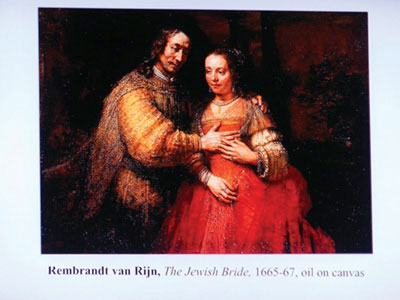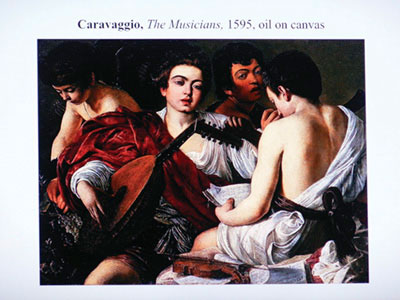
What makes a masterpiece? Over the past few weeks, the Triton Museum of Art has been laying out the lengthy list of criteria that must be met in order for a work of art to be considered a masterpiece in its “A Curator’s Eye: Discerning a Masterpiece” lecture series.
So far, it’s been said that a masterpiece must have ambivalence, irony, strangeness, originality, aesthetic splendor, creatively misread its precursors, have cognitive power and be a metaphor. And, on Feb. 27, Chief Curator Preston Metcalf continued the series with two additional pieces of criteria – a masterpiece demands re-experiencing and projects self-change through subject inwardness.,/
Metcalf explained the demand by showing a Mark Rothko’s “Green and Maroon,” and telling a story about how his son taught him to appreciate Rothko. Metcalf hated Rothko, but when Morgan Metcalf was three, he told his dad that he loved “Green and Maroon” because it reminded him of Christmas – and suddenly everything made sense. “Did Mark Rothko want us to think of Christmas? No … he wanted to incite an emotion. To incite a thought … Because [my son] showed me, I was ready [to understand Rothko]. It demanded to be re-experienced … You can look at this a million times and every time it will be something different.”
The same was said for William-Adolphe Bouguereau’s “The Broken Pitcher,” and Metcalf’s favorite painting, Rembrandt’s “The Jewish Bride.” “‘The Jewish Bride’ is my favorite painting because in it I see a couple celebrating the wonder of finding one another at a maturing point in life. In it, I see me and Kay, my lovely bride. I had to be ready for it. It took my years to be ready for this. And now, when I look at it … It’s new to me all over again.”
To detail a masterpiece’s need to project self-change through subject inwardness, Metcalf used Titian’s “The Flaying of Marsyas,” which is a quadruple self-portrait. The first rendition of Titian is a young boy looking out at the viewer. The second is a viola player. The third is an old man and the final is Marsyas.

“This is one of those rare pieces where you can see an artist showing himself, transforming himself, in one canvas,” said Metcalf. “That’s what we mean by self-change. He’s listening to himself.”
Through additional paintings, Metcalf showed how each piece, from paintings by Caravaggio to Picasso, showcased this demand and ultimately how every piece was about the viewer. “All great works of art are about you – every one of them,” said Metcalf. “If it’s a great work of art, ultimately the metaphors lead to one place – you … Art should be very, very personal. The reason it’s so personal to me is because all of this criteria reminds me, every time, that all of these works that I’m showing you are me. They’re about me. They’re for me. And when you’re looking at it, it’s about you. ‘Guernica’? It’s about you. ‘The Jewish Bride’? You don’t know it yet, but it’s about you. Every one of them [is about you].”
The lecture series continues Thursday, March 6, where Metcalf will discuss the final two criteria – that a masterpiece is larger than any social programming and that it instills a fear of mortality within the viewer. Drop in fee is $20. Lectures begin at 7 p.m. Visit www.tritonmuseum.org for more information.





